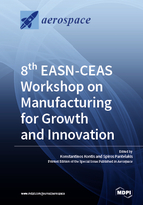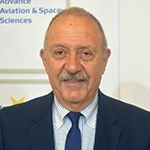8th EASN-CEAS Workshop on Manufacturing for Growth and Innovation
A special issue of Aerospace (ISSN 2226-4310).
Deadline for manuscript submissions: closed (31 January 2019) | Viewed by 68541
Special Issue Editors
Interests: aerodynamic technologies; flow and flight control systems; shock physics; aerospace design and optimization; flow diagnostics
Special Issues, Collections and Topics in MDPI journals
Interests: aeronautical materials and structures; mechanical behaviour of materials; structural integrity; damage mechanics; experimental fracture mechanics; fatigue of aircraft materials and structures; ageing aircraft; characterization and manufacturing processes of polymers, thermosetting and thermoplastic composites; nanocomposites and nanocrystalline alloys; multifunctional and self-healing materials
Special Issues, Collections and Topics in MDPI journals
Special Issue Information
Dear Colleagues,
The 8th EASN-CEAS International Workshop aims to build on the success of the series of EASN and CEAS events by becoming an even broader and even more comprehensive gathering.
The conference will include a number of Plenary Talks by distinguished personalities of the European Aviation sector from academia, industry, the research community and policy makers. It will also include Thematic Sessions on a series disciplines of the A&AT Manufacturing domain, along with Technical Workshops, where evolving ideas, technologies, products, services and processes will be discussed. Research projects are invited to exploit the opportunity and disseminate their results and achievements in dedicated Sessions.
This Special Issue is cooperating with the 8th EASN-CEAS International Workshop on “Manufacturing for Growth and Innovation” (https://easnconference.eu/), to be held in Glasgow, UK, 4–7 September, 2018. Authors of outstanding papers related to aerospace manufacturing are invited to submit extended versions of their work to this Special Issue for publication.
Prof. Dr. Konstantinos Kontis
Prof. Dr. Spiros Pantelakis
Guest Editors
Manuscript Submission Information
Manuscripts should be submitted online at www.mdpi.com by registering and logging in to this website. Once you are registered, click here to go to the submission form. Manuscripts can be submitted until the deadline. All submissions that pass pre-check are peer-reviewed. Accepted papers will be published continuously in the journal (as soon as accepted) and will be listed together on the special issue website. Research articles, review articles as well as short communications are invited. For planned papers, a title and short abstract (about 100 words) can be sent to the Editorial Office for announcement on this website.
Submitted manuscripts should not have been published previously, nor be under consideration for publication elsewhere (except conference proceedings papers). All manuscripts are thoroughly refereed through a single-blind peer-review process. A guide for authors and other relevant information for submission of manuscripts is available on the Instructions for Authors page. Aerospace is an international peer-reviewed open access monthly journal published by MDPI.
Please visit the Instructions for Authors page before submitting a manuscript. The Article Processing Charge (APC) for publication in this open access journal is 2400 CHF (Swiss Francs). Submitted papers should be well formatted and use good English. Authors may use MDPI's English editing service prior to publication or during author revisions.
Keywords
- Factory of the future
- Industry 4.0 for manufacturing
- Electrification
- Robotics and automation
- Nanofabrication
- Cyber-security
- Advanced structures and materials
- Modelling and simulation
- Integrated aircraft design
- Sustainable manufacturing growth
- Vehicle health management and through-life engineering services
- Green manufacturing
- Design and prototyping
- Additive manufacturing
- Augmented reality
- Virtual reality
- Precision engineering
- NDT
- Virtual Factory
- Surface Engineering
- Nanomaterials and Nanotechnologies
- Self-healing materials and structures
- Disruptive design concepts
- Virtual testing through the scales
- Multi-scale models
Related Special Issues
- 13th EASN International Conference on Innovation in Aviation and Space for Opening New Horizons in Aerospace (15 articles)
- 9th EASN International Conference on Innovation in Aviation & Space in Aerospace (9 articles)
- 10th EASN International Conference on Innovation in Aviation & Space to the Satisfaction of the European Citizens in Aerospace (12 articles)
- 11th EASN International Conference on Innovation in Aviation & Space to the Satisfaction of the European Citizens in Aerospace (20 articles)
- 12th EASN International Conference on Innovation in Aviation & Space for Opening New Horizons in Aerospace (20 articles)







